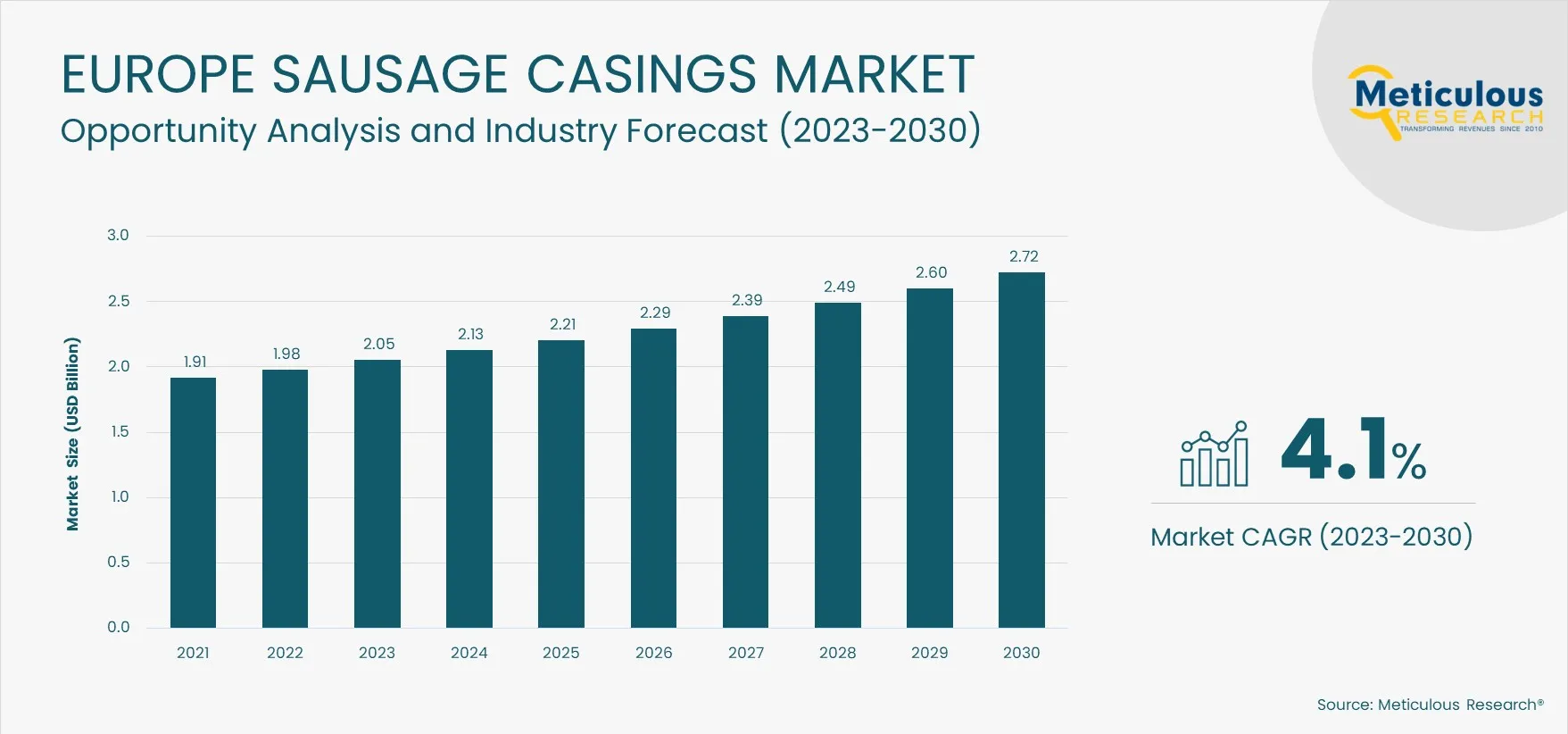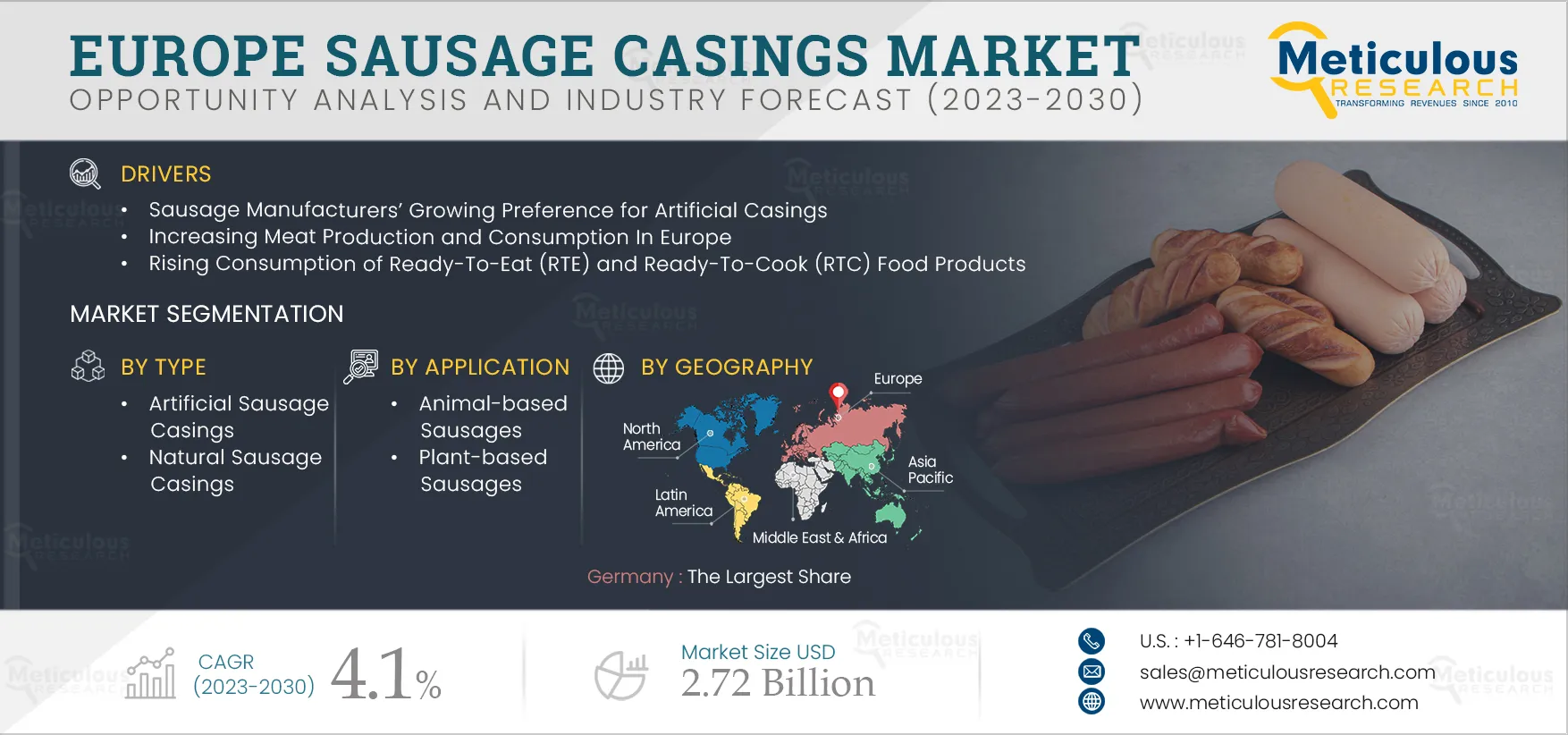The Europe Sausage Casings Market is projected to reach $2.72 billion by 2030, at a CAGR of 4.1% during the forecast period 2023–2030. The Europe Sausage Casings market is projected to reach $2.72 billion by 2030, at a CAGR of 4.1% during the forecast period (2023–2030). The growth of this market is driven by the growing preference for artificial casings by sausage manufacturers, increasing meat production and consumption in Europe, and the rising consumption of ready-to-eat and ready-to-cook food products. However, complexities in the use of natural sausage casings restrain the growth of this market. The emergence of vegetarian sausage casings is expected to generate growth opportunities for the players operating in this market. However, animal disease & health concerns are a major challenge for market growth.
Here are the top 10 companies operating in the Europe Sausage Casings Market
Viscofan, S.A. (Spain)
Viscofan is engaged in producing and distributing artificial casings for the meat industry. The company operates through two business segments: Traditional Business, New Business, and Energy. The company’s products include cellulose, collagen, fibrous, and plastic casings.
With sales offices and production sites in Spain, Germany, Belgium, the Czech Republic, Serbia, China, the U.S., Brazil, Mexico, and Uruguay, the company has a geographic presence across North America, South America, Europe, and Asia-Pacific.
Viskase Companies, Inc. (U.S.)
Viskase is mainly involved in food packaging solutions and services. The company offers cellulose casings, plastic casings, fibrous casings, netting & fabric, and transfer casings. The company also provides value-added support services related to these products for global consumer products companies.
The company has a geographic presence across North America, Europe, South America, Asia-Pacific, and Middle East & Africa.
DAT-Schaub Group (Denmark)
DAT-Schaub Group, a subsidiary of Danish Crown AmbA, is engaged in sourcing, producing, warehousing, marketing, and distributing sausage casings and ingredients to the food industry. The company mainly operates through four business segments: Industry, Retail, Foodservice, and Other. The company offers cellulose, collagen, fibrous, and plastic casings through the Fresh Meat, Foods, and Casings segment.
The subsidiaries of the company, DAT-Schaub A/S (Denmark), Thomeko Eesti Oü (Estonia), DAT-Schaub Finland Oy (Finland), DAT-Schaub France S.A.S. (France), DAT-Schaub Norge AS (Norway), DAT-Schaub Polska Sp. z o.o. (Poland), DAT-Schaub AB (Sweden) and DCW Casing LLC (U.S.) manufacture artificial casings. The company has a geographic presence across North America, Europe, Asia-Pacific, Latin America, and the Middle East & Africa.
Devro Plc (U.K.)
Devro is engaged in the manufacturing and supply of collagen casings to the food industry. The company provides a wide range of collagen casing products and technical support to manufacturers of sausages, salami, hams, and other cooked meats under the Coria, Cutisin, and Devro brands.
With manufacturing sites in the U.S., U.K., Czech Republic, and Australia, and sales offices in Russia, New Zealand, China, Japan, and the U.S, the company has a geographic presence across North America, Europe, Asia-Pacific, Latin America, and the Middle East & Africa.
Peter Gelhard Naturdärme KG (Germany)
PeterGelhard Naturdärme is involved in procuring, processing, packaging, and supplying natural casings products. The company offers natural casings derived from sheep, hogs, and beef under the brand name Rheingold. The company’s main procurement sources for natural casings are in Australia, China, New Zealand, South America, the Middle East, and Europe. With several manufacturing and storage facilities in Germany, Poland, and China, the company sells its casing across North America, Europe, Asia-Pacific, Latin America, and the Middle East & Africa.
CDS Hackner GmbH (Germany)
CDS Hackner is involved in the manufacturing and selling of natural casings, special meat cuts & offal, and frozen food services. The company offers hog casings, sheep casings, beef casings, CDS freshpack, and SilberPfeil through its natural casings segment.
The company has its own and contracted production sites in China, Turkey, Lebanon, and Germany. The company has a geographic presence across North America, Latin America, Europe, Asia-Pacific, and Middle East & Africa.
Combinatie Teijsen VD Hengel (CTH) BV (Netherlands)
CTH, a subsidiary of Darling Ingredients, is involved in collecting, manufacturing, and selling fat-& after-ends, meat by-products, and natural casing products for food, pet, pharmaceutical, and sausage companies. The company offers natural casings from cattle, pig, sheep, and horse.
With manufacturing facilities in Germany, Belgium, Poland, Spain, Portugal, China, the U.S., and Brazil, the company has a geographic presence in Germany, Asia-Pacific, North America, and South America.
ViskoTeepak Holding Ab Ltd (Finland)
ViskoTeepak Holding is a part of the Eriksson Capital Group and was formed at the beginning of 2007 when Visko and Teepak joined forces. The company manufactures collagen, cellulose, fibrous, and plastic casings for the food industry. Its products are used for effectively processing and packaging frankfurters, hot dogs, dry and semi-dry sausages, smoked meats, hams, deli meats, poultry, dairy products, and other similar products.
With production and conversion plants in Finland, Belgium, Mexico, Netherlands, U.S., Czech Republic, and Poland; and sales offices in Germany, Russia, Mexico, Thailand, and Finland, the company has a strong geographic presence across North America, Europe, Asia-Pacific, Latin America, and Middle East & Africa.
Selo B.V. (Netherlands)
Selo B.V. is engaged in the production of artificial casings for the meat industry. The company provides edible collagen casing, non-edible collagen casing, collagen films, cellulose casing, fibrous casing, plastic casing, meat netting, and plant-based casings. In addition to manufacturing and supplying a wide range of artificial casings, the company specializes in food processing systems, meat processing machines & packaging machines for food, pharmaceutical, animal feed, and non-food products, primarily across Europe.
With sales offices in the Netherlands, U.K., Belgium, France, and Denmark, the company has a strong geographic presence across Europe, North America, Asia-Pacific, Latin America, and the Middle East & Africa.
Kalle GmbH (Germany)
Kalle GmbH is engaged in the manufacturing of sausage casings. The company offers value-added casings, fibrous casings, polymer casings, nettings, and textile casings. Apart from the casings, the company also produces sponge cloths, functional ingredients, and various other products.
With sales partners in Austria, Chile, Czech Republic, Hungary, Netherlands, Poland, the U.K., and the U.S., the company has a geographic presence across North America, Latin America, Europe, Asia-Pacific, and the Middle East & Africa.
Popular Mention: Amjadi GmbH (Germany), Fibran Group (Spain), FABIOS S.A. (Poland), Oversea Casing Company (U.S.), Nutra Produkte AG (Switzerland), Strobel GmbH & Co. KG Boyauderie Sarroise (Germany), MCJ Casings (U.K.), and Irish Casing Company (Ireland).

























